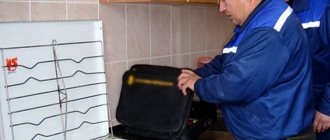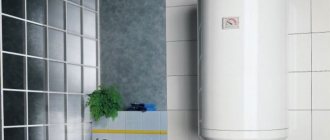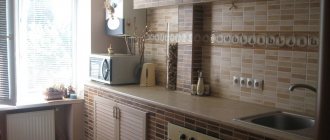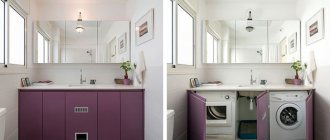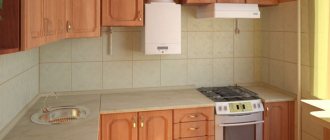Types of water heaters
Water heaters are divided into gas and electric . The first are called “columns”; they provide rapid heating of running water and are suitable for a private home, but their installation requires effective ventilation. Systems powered by electricity can be used in apartment buildings. Their installation does not need to be coordinated with utility services. Such water heaters are instantaneous or storage.
Cumulative
The boiler is equipped with a container in which cold water is accumulated and heated. These devices consume a minimal amount of electricity and allow you to have a supply of heated liquid. The main disadvantage of the device is its dimensions, which limit possible installation options. The devices differ in design and technical characteristics. When choosing a boiler, pay attention to the service life. It depends on the type of heating element - heating coil.
By design, boilers are divided into the following types:
- With dry heating element. In this case, the heating element does not come into contact with water.
- With a wet heating element. The heating coil comes into contact with the liquid. The device has a shorter service life, which is explained by the rapid failure of the heating element.
Flow-through water heating systems
Flow systems are considered the most convenient option for installation in the bathroom.
There are 3 types of such water heaters:
Stationary water heater for the bathroom.
Stationary. They are installed as a separate element, which is explained by their dimensions. The device is placed under the sink or bathtub. The first is equipped with a decorative cabinet that hides the heating system.- Mixer attachment. The universal device is placed on the tap tube in front of the swivel spout. Such a device is suitable for washing or washing dishes. A small heater cannot provide water supply for taking a shower or bath.
- Electrically heated faucet. A modern heating device has a separate mixer. The principle of operation is no different from that of nozzles. The heating rate depends on the pressure in the pipeline. The system can be used in the absence of hot water supply. You won't be able to take a bath; the water gets cold quickly. For a shower stall, a heated faucet is considered a good option. The system can be installed with your own hands; it consumes a small amount of electricity.
What do you need to know about the gas water heater?
Houses with a gas water heater are predominantly of the “old stock” - they often want to remodel them, connect a room with a kitchen, or simply enlarge the kitchen at the expense of adjacent rooms, such as a corridor.
And here difficulties arise - since combining gasified kitchens with living rooms is prohibited due to fire safety rules. Moreover, even with moving the speaker into the kitchen itself, difficulties can arise - and their degree depends on how far you are going to “remove” the speaker. But in any case, coordination is necessary. To do this, you need to contact gas services.
- Technique
How to choose a instantaneous gas water heater: 6 important parameters and useful tips
Choosing an installation location
The easiest way is to install a boiler near a branch of the water supply system in the area between the riser and the plumbing fixture. The water heater can be left in the kitchen, bathroom, or toilet. Less commonly, the device is installed in corridors.
The modern design of the device does not require camouflage. However, most owners of houses and apartments hide water heaters in boxes, niches or cabinets.
Bathroom
Separate bathrooms have a large passage capacity, allowing several residents to carry out hygiene procedures at the same time.
When installing a water heater in a bathroom, consider the following points:
- The room most often has a minimum area (no more than 4 m²).
- Due to the lack of free space, storage water heaters are inconvenient to install.
- There are no risers for sewerage, cold water and hot water, which does not allow making a box.
- For the bath and sink use one rotary mixer or two separate taps.
- One wall is occupied by a bathtub, the other by a heated towel rail.
Combined bathroom
Combined bathroom.
A combined bathroom is present in Khrushchev apartments. Hidden installation of the boiler is carried out during the renovation of secondary housing.
The drive can be installed using several methods:
- in the niche behind the toilet;
- in a box for water supply pipes;
- under the washbasin in the cabinet;
- in the closet above the washing machine or toilet;
- on the mezzanine above the door.
When using the last two methods, connecting the device to the pipeline causes difficulties. Violation of the tightness of connections leads to damage to furniture or household appliances.
Toilet
The toilet is the smallest room in the apartment; in a private house, a large area is allocated for this room. Plumbing fittings, metering devices, and water supply risers are located here. The project includes a niche located behind the toilet, or a box for masking pipes. These structures are used to hide the water heater.
The boiler installed in a niche is decorated with blinds. Other options when placing the device in the toilet are not used.
Connection diagrams
The installation diagram of a heater in a bathroom includes the following points:
Water heater connection diagram.Piping the water supply system. A connection is made into the water supply system after the riser valves. A safety valve with drainage is installed at the inlet to the heater. After this, shut-off valves are installed. There are 2 flexible tubes leading from the boiler. The drainage line is connected to the sewer.
- Connection to the electrical network. In this case, installation of grounding and a circuit breaker is required. To power the device, a separate socket with a voltage of 220 V is used. The connection diagram to the electrical network can be seen in the photograph.
Preparing for installation
At the preparatory stage, the installation location is selected, tools and materials are purchased, and a connection diagram is drawn up.
To complete the work you will need the following components and additional elements:
- Plumbing, construction tools. Wrenches, pliers, a hammer drill, a set of screwdrivers, wire cutters, and a tape measure will come in handy.
- Materials for arranging a water supply system. You will need metal-plastic pipes, flexible hoses, adapters, sealing tape, tow, and shut-off valves.
- Materials for connecting the device to the electrical network. Use three-wire wires, an automatic fuse, and a socket.
Features of installation work
Ideal fastening - dowels with plastic tips
First you need to choose the right installation location. It is worth taking into account the fact that water taps and an electrical panel should be nearby, this will increase ease of use. Also, the design itself should not take up extra space, it should look harmonious and not interfere with movement around the room. The first step is checking the strength. You need to draw markings on the wall.
After this, the creation of holes begins, plastic dowels are driven in, and a homemade shield is installed to improve strength. Each boiler model has several mounting plates with eyes. They are at the back. You need to insert an anchor inside the hole and screw it into a plastic dowel. It is also recommended to use hooks, they are easier. I just hung the structure through the eyes and that’s it.
Installation and connection of a water heater
There are 2 installation methods - permanent or temporary.
In the second case, perform the following actions:
- Install the Titan boiler on the wall. The distance between the device mounts is measured with a tape measure and the surface is marked. Using a hammer drill, create holes for the bolts. After installing the anchor hooks, the boiler is hung in place.
- Connect the water heating system. The cold water supply pipe is equipped with a tee. Install shut-off valves and connect the shower faucet to the boiler outlet.
The permanent installation of a instantaneous water heater is carried out so that it functions synchronously with the water supply system.
Bathroom water heater option. This is interesting: Gas storage water heater: types and operating principles of gas boilers
To do this, perform the following steps:
- Adapters are inserted into the water line. Install shut-off valves.
- Connect the cold water supply pipe to the boiler. The connection location is marked in blue.
- The heater outlet is connected to the mixer using a metal-plastic pipe and tee.
- Check the tightness of the connections. If there is a leak, the joints are coated with sealant. If everything is done correctly, the plug of the device is inserted into the socket.
Installation of the heater on a wall made of brick, wood, plaster, cinder block, concrete
Brick, concrete and cinder block are durable building materials, but they vary in density and quality.
For example, to secure a water heater to a hollow cinder block, use stud bolts that are installed through the walls. Screw-in hooks of suitable length are also suitable for cinder blocks; they are mounted on plastic inserts.
If the wall is made of white brick, the boiler can be installed on anchor screws or using studs with collets. It is important that the fasteners are long, approximately 150 mm.
It is unacceptable to mount the water heater on a thin wall made of half a brick.
The recommended wall thickness is 150-250 mm, with this thickness the heater will hold firmly. And if the wall is made of red brick, a metal shield is welded and secured to the wall with four dowels or pins all the way through.
If the wall is concrete and the concrete has a high density, using plastic dowels is sufficient. Their length should be 80-120 mm. Instead of dowels, pins with collets are used. If the concrete wall is loose, it is recommended to secure a metal frame or shield; the water heater is attached to this frame.
To install the boiler on a wooden log or beams, lay some non-combustible materials.
If the wood is strong, brackets are screwed into it to hang the heater.
Wood becomes less durable over time; it is recommended to use a metal plate as a non-flammable lining; it will distribute the load of a heavy water heater evenly over the entire area.
If the interior partition is made of wood, then the metal shield is secured to such a partition with metal pins, they are passed through the partition and secured with nuts, and wide washers are placed under them.
It is not possible to install a water heater on plasterboard. In this case, a ceiling is used, onto which steel strips are fixed; their thickness is at least 3-4 mm.
One edge of the strip is fixed to the ceiling, and the second to the plaster wall using dowels. Bolts are welded or screwed onto these metal strips; the boiler will be installed on them.
Designs for masking the boiler
Water heaters can be installed without additional decoration. It is difficult to choose a ready-made cabinet to hide such a device. The exception is devices intended for installation under the sink. Sometimes structures for masking a water heater are assembled by hand.
Box
The box is a structure protruding in relation to the wall. It is assembled from plasterboard and installed on a metal frame. Unlike a cabinet, the box is non-demountable. Instead of a door, an inspection hatch is used.
Installation of the box involves the following actions:
- Boiler installation. The device is connected to water supply and power supply systems in a standard way.
- Installation of the frame. The guide profiles are installed first, after which the front pillars are placed. The assembly of the frame is completed by fixing the stiffeners and jumpers.
- Sheathing. Drywall sheets are attached to the profiles with self-tapping screws. Surfaces are treated with water-repellent antiseptic impregnation. The outer parts of the box are tiled.
Box for masking the water heater.
Niche behind the toilet
In this case, installation of side walls is not required, which reduces repair time and consumption of building materials. The water heater in the interior is hidden using blinds. Pipes interfere with the installation of standard fasteners, so brackets are used. A stepped box is formed by building up the wall above the plumbing fixture.
Mezzanine
The mezzanine used for storing things can be turned into a niche to accommodate a water heating system. The shelf is covered with doors or curtains. A storage device is placed on it.
To make a mezzanine with your own hands, perform the following steps:
- make markings on opposite walls of the corridor;
- install bars or metal profiles;
- a shelf is placed on the frame;
- install and connect the boiler;
- install blinds.
The mezzanine is only suitable for installing horizontal devices. Vertical models cannot be laid on their sides.
Closet
A large-volume storage water heater can be hidden in a built-in closet. Water and sewer pipes are pulled through the wall separating the corridor from the bathroom. The cabinet has a simple design. The doors move along guides. No side walls required. The boiler is placed at the bottom of the furniture. The remaining space is used for storing things.
Floor stand
Due to its small size, the cabinet is not suitable for installing volumetric storage heaters. A two-door piece of furniture can accommodate a boiler with a capacity of up to 80 liters. It is installed on a shelf or mounted on the wall of the room. The back part of the cabinet is dismantled.
Water heater hidden from view.
Masking with finishing materials
The boiler body, made in a classic style, harmonizes with the interior of any room.
There are ways to help visually hide the device:
- creating an appropriate color background;
- painting the device body;
- camouflage with furniture, use of decorative overlay.
These techniques help keep the heater out of sight.
How to decorate a column?
To make it less conspicuous, try hiding it.
Close up with kitchen set
This solution is possible, but the cabinet for the speaker should not have a bottom and top wall - it is necessary that there is free air circulation. Sometimes, in order to fulfill this decision, you have to make a set to order - with non-standard cabinet depths or heights. For example, in this kitchen the gas heater is hidden behind a false cabinet without a side wall.
Photo: Instagram belova_design
- Kitchen
Kitchen design with a geyser (25 photos)
Paint it the same color as the walls
Or choose a light finish to match the color of the column. This technique will visually “dissolve” it in space. But, of course, it won’t hide it completely.
Photo: Instagram viraiva_home
Slide into a corner
Remember about approval? If you decide to move the column into a corner, you can cover it with a corner cabinet - by the way, this will solve the issue of usable space, since corner cabinets are often the most useless. Or just disguise it between the cabinets, which is also good.
Photo: Instagram kuhnivolot
Choose a boiler to match the color of the set
Now there are really stylish and aesthetic gas boilers and water heaters.
Photo: Instagram hubert_almaty
Purpose of the water heater
Among traditional, modern energy carriers for the conditions of the Russian Federation, there is no worthy alternative to natural gas in centralized supply systems. This guide discusses the installation of an electric water heater, which heats water exclusively when the hot water supply is turned off or gas lines are prevented in apartments with water heaters using this type of fuel.
That is, the water heater is an additional source of boiling water for baths, faucets, and showers. And the owner wants to hide the boiler in the bathroom or other rooms of the apartment to increase the decorative value of the interiors. In this case, the heater can be used for one plumbing fixture or supply hot water to all faucets in the house.
Yak povsiti water heater additional assistance fakhvtsv
Connection diagram for a wall-mounted water heater.
If you are unable to secure the water heater on your own, you can contact the security guards for help. Their obligations are as follows:
- The specialist is responsible for transferring costs to the deputy for materials that are processed during the hour of work. The work plan and their evaluation are also to blame.
- The master is responsible for the visconty's dismantling of the old building, as it is present.
- A specialist will install the boiler mounting (mountings for water heaters can be purchased at plumbing stores).
- After fixing the connection, the master is responsible for not connecting the pipes for supplying and discharging water.
- After installation and connection of water heating to the water supply and electrical systems, the technician must check the device for functionality, and then demonstrate it to the repairman. If any problems with the construction are discovered in the near future, the contractor is responsible for immediately fixing them, in which case there is no need to pay extra for them.
- The claims specialist will provide consultation to the client on how to use it, briefly informing them about how to use the installed device.
Malyunok 3. When connected to the wall, the water heating system will look compact in the interior of the booth.
It is clear about the materials and tools that may be needed to secure the heating of water to the wall, you should know that in most cases, manufacturers will use their materials and tools. You need to pay extra for them.
I am purchasing materials to secure the heating of water to the wall on the right, because other elements will be needed. Their presence is confirmed by falsification. It is necessary to expand the situation if the sellers are trying to reach their clients. You can find out if you ask for cash in writing.
When installing the boiler, it must be installed strictly vertically. In some cases, the water heater tank cannot be reached through the loosening of the fastening plate. If this is the case, then it is necessary to place a lining at the bottom of the structure, which is made from thick gum.
The reliability of the fastening can be verified. For this purpose, hang on the frame, clinging to the dowels, in order to wash from the walls, after which the bits will crumble in the ragged sides. Since the structure is flexible, it means that a water heater can be installed, since it has more water than the average person.
Attachments to the water heating wall can be added to Fig. 3.
You can learn how to practically mount a water heater on the wall in your home yourself. We need to follow all the rules so that when the water heater goes out of service, it won’t cause any problems or problems.
Connection diagrams
Clause 6.37 of SNiP 2.04.08 prohibits the installation of gas appliances in bathrooms for the following reasons:
- room volume is less than 15 m³ (6 m² with standard ceiling height);
- there is no chimney according to SNiP 2.04.05, and it is prohibited to connect a column to the ventilation hood;
- There is no window with an opening transom in the room.
Taking into account the above, electric water heaters should be used in apartments. During scheduled boiler room maintenance in the absence of hot water supply, residents will be provided with hot water from a boiler or instantaneous heater.
To install a boiler in the bathroom without violating the SP, PUE, you must perform the following sequence of actions:
- piping the water heater water system;
- connection to 220 V power supply.
Tying is done according to the following scheme:
- insertion into cold water and hot water lines after riser valves;
- a safety valve with a drain line is installed at the entrance to the boiler;
- after it a drain tap/valve is installed.
When connecting the electrical part, it is necessary to install a grounding device, an RCD or a differential circuit breaker as required by the water heater manufacturer in its data sheet.
Thus, two flexible hoses in a metal braid depart from the storage wall-mounted boiler or instantaneous water heater, a drainage tube that must be connected to the sewer system.
For power supply, there must be a 220 V socket with grounding nearby, a differential circuit breaker or an RCD device. There are two shut-off valves at the cold water inlet, and one tap at the hot water outlet. That is, hidden installation will require additional space, and the device itself cannot be removed far from the water supply and sewage system.
Details about electrical wiring and installation of electrical equipment in the bathroom are written in this article.
Rules for operating water heating equipment
It is worth noting that the key to successful operation of water heating equipment for a long time is compliance with the rules for using water heaters. Here are the main ones:
- experts advise removing the heating element at least once a year and checking it for scale deposits, and this is due to the fact that at the maximum heating temperature of hard tap water, scale forms in the heating element, as a result of which heat transfer decreases, the system overheats and stops functioning; in this case, you have to change the heating element;
- It is forbidden to hang the heating element if there is no grounding in the room, since drops of water falling on the body can damage the device, as a result of which the possibility of electric shock to a person cannot be excluded,
- It is prohibited to connect an empty storage boiler to the electrical network;
- if there is an excess pressure of more than 6 atm in the city water supply network, then it is necessary to install a pressure reducer;
- It is not allowed to connect the heater to the water supply network without installing the safety valve that comes with the water heater;
- Water must not be discharged from a storage heater connected to the network;
- The consumption of water from the water heater as drinking water is excluded.
Flow or storage heater
An electric water device should be selected according to its characteristics:
| Characteristic | Water heater type | |
| Cumulative | Flow-through | |
| Electric power | from 1.5 kW | from 3 kW |
| Dimensions | large | small |
| Price | high | low |
| Hot water volume | 200 l/4 hours | 200 l/h |
| Operating mode | long | intermittent |
| Service | permanent | not required |
| Water pressure | low | high |
This is interesting: What to do if the pipes in the bathroom are loudly humming
In 85% of cases, apartment owners in the Russian Federation choose a storage boiler:
- 30 l – for one user;
- 70 l – married couple;
- 150 l – for all water intake points;
- 210 l – large family, boiler for kitchen and bathroom.
There are storage heaters of the following types:
- wall;
- floor;
- vertical;
- horizontal;
- flat;
- short, large diameter;
- narrow elongated;
- pressure;
- atmospheric.
For spare hot water supply lines, used only at the time of shutdown of the central hot water supply or maintenance of the gas pipeline of the dispenser, only direct-acting heaters with electric heating elements are used. Indirect heating devices with heat exchangers are not suitable for these purposes.


